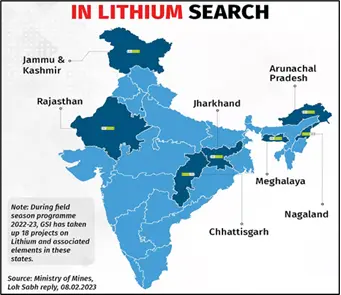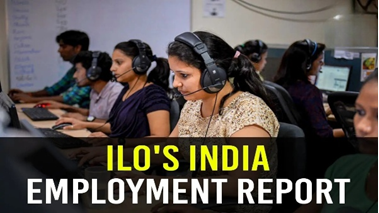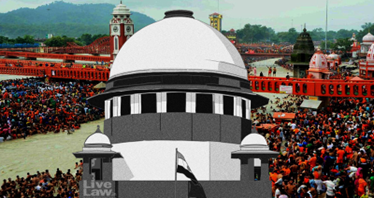Friday, 2nd August 2024
Why New Guidelines for Arbitration and Mediation
Why in the news?
- The government has introduced a new office memorandum with guidelines for arbitration and mediation in domestic public procurement contracts.
- This memorandum, while ostensibly promoting mediation, signifies a major shift from arbitration to litigation for government contracts.
- The move has significant implications for the legal system, business environment, and attractiveness of India as a foreign investment destination.

Shift from Arbitration to Litigation:
- Current Situation:
- The memorandum suggests that post-resolution of existing arbitration cases, future disputes will be resolved through traditional courts rather than arbitration.
- This change is expected to place additional strain on the already overburdened judicial system.
- Industry Response:
- Despite objections from industry groups and the Arbitration Bar of India, the transition to litigation seems definitive for the foreseeable future.
Implications of the Government’s Decision:
- Increased Burden on Courts
- Current Strain: India’s court system is already experiencing a significant backlog, leading to delays in dispute resolution.
- Impact of Transition: The shift to litigation will exacerbate these delays, resulting in longer wait times, extended trial durations, and increased frustration among litigants.
- Impact on Ease of Doing Business
- Ease of Doing Business Index: The transition away from arbitration, which is generally more efficient and less adversarial, could negatively affect India's ranking in the Ease of Doing Business index.
- Foreign Investment: The perception of a slow and overburdened court system may deter foreign investors, potentially reducing Foreign Direct Investment (FDI) and impacting economic growth.
- Increased Costs for Litigants
- Cost Implications: Litigation typically involves higher costs than arbitration, including legal fees, court appearances, and related expenses.
- Impact on SMEs: Small and medium-sized enterprises (SMEs) may find these costs prohibitive, which could discourage them from pursuing legitimate claims or defences and create inequities in access to justice.
- Extensive Appeals Process
- Complexity of Appeals: Litigation often involves a lengthy and complex appeals process, unlike arbitration where the scope for appeals is limited.
- Business Uncertainty: The extended appeals process can prolong disputes, creating uncertainty for businesses and potentially hindering strategic decision-making and operational efficiency.
- Court Interference and Judicial Overreach
- Increased Interference: The shift to litigation could lead to greater court interference in commercial disputes, which was one of the reasons for promoting arbitration initially.
- Judicial Overreach: Increased court involvement can result in inconsistent rulings and further delays, diminishing the predictability and stability that businesses seek.
- Impact on Legal Representation
- Disparities in Representation: Government entities may engage less experienced legal teams compared to private parties, leading to an imbalance in the quality of legal representation.
- Effect on Fairness: This disparity could skew the fairness of the legal process, where outcomes may be influenced more by the quality of legal advocacy than by the merits of the case.
- Long-Term Legal Precedents
- Potential Benefits: The increased volume of commercial litigation may contribute to the development of robust legal precedents in areas such as damages, indemnities, and trial principles.
- Investment Needed: Realising this potential requires substantial investment in judicial infrastructure and capacity building to effectively manage the increased caseload.
Misconceptions and Real Issues in Arbitration:
- Perceived Issues: There is a misconception that arbitration failures are due to inferior quality or corruption of arbitrators.
- Contradictions: India promotes itself as an arbitration hub with high-quality talent but simultaneously criticises its own arbitrators, creating a contradictory narrative.
- Addressing Real Issues: Addressing quality or corruption issues in arbitration should involve improving accreditation and training rather than abandoning arbitration altogether.
Case Study: Real Estate Sector:
- The real estate sector, heavily reliant on long-term investments, faces increased tax liabilities without the benefit of indexation.
- For example, an investor who purchased property in 2000 and sold it in 2024 would now pay higher taxes on the capital gains due to the absence of indexation benefits, which would have adjusted the purchase price for inflation over 24 years.
Case Study: Mutual Funds and REITs:
- Mutual funds and REITs, which attract long-term investors due to their steady returns and tax benefits, will be less attractive.
- Investors might shift to short-term investments or other financial instruments to avoid higher LTCG taxes, leading to potential volatility in the market.
Way Forward:
- Legal Reform: India should enhance its laws on damages and indemnities and encourage the use of creative legal strategies.
- Development of Skills: The increased volume of commercial litigation will drive demand for skilled trial lawyers, strengthening the legal ecosystem.
- Government Investment: Effective management of this transition requires substantial investment by the Government of India in legal infrastructure and training.
Conclusion
The shift from arbitration to traditional litigation presents significant challenges for India’s legal and business environments. While the immediate impact appears negative, there is potential for long-term improvements in the legal infrastructure and development of commercial law jurisprudence. If managed effectively, this transition could enhance the robustness and capability of India’s legal system in handling modern commercial disputes.
|
UPSC Civil Services Examination Previous Year Question (PYQ) Prelims Q1. With reference to Lok Adalats, which of the following statements is correct? (2010)
Ans: (d)
Mains Q:1 What are the major changes brought in the Arbitration and Conciliation Act, 1996 through the recent Ordinance promulgated by the President? How far will it improve India’s dispute resolution mechanism? Discuss. (2015) |
Source: IE
Hamas chief assassinated
Why in the news?
- Recently, on July 31, 2024, Ismail Haniyeh, a prominent leader of Hamas, was assassinated in Tehran, Irsording to Hamas, the assassination was carried out by an Israeli “strike” on his residence. The Israeli military has not yet commented on the incident.
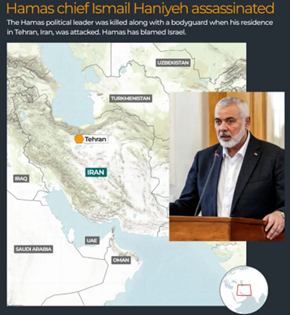
About the Hamas:
- Description:
- Hamas is the largest Palestinian militant Islamist organisation and a major political faction in the region.
- It currently governs over two million Palestinians in the Gaza Strip and is known for its armed resistance against Israel.
- Hamas, or its military wing, is designated a terrorist organisation by Israel, the United States, the European Union, the United Kingdom, and other countries.
- Background:
- Established in the late 1980s during the first Palestinian intifada against Israeli occupation, Hamas originated from the Palestinian Muslim Brotherhood.
- It was formed in response to the perceived failures of the Palestine Liberation Organization (PLO), which had made significant concessions, including recognizing Israel and abandoning armed struggle in favour of negotiations.
- Reasons for Creation:
- The creation of Hamas was driven by disillusionment with the PLO’s concessions, particularly the recognition of Israel and the abandonment of armed resistance.
- Hamas opposed the Oslo Peace Accords signed between Israel and the PLO in the early 1990s.
- India’s Stance on Hamas:
- Current Position:
- India has not designated Hamas as a terrorist organisation. While India supports the Palestinian cause, it maintains a balanced approach that opposes terrorism.
- Following the October 7, 2023, attack by Hamas, PM Modi expressed solidarity with Israel but did not specifically mention Hamas or Palestine.
- India advocates for a two-state solution to the Israel-Palestine conflict.
- Current Position:
Key takeaways from assassination of Hamas chief:
- Impact on Iran and Hamas:
- Details of Assassination:
- Ismail Haniyeh was killed in Tehran, where he had travelled for the inauguration of Iranian President Masoud Pezeshkian.
- This event has heightened tensions, with Iran vowing retaliation. The assassination suggests that Hamas leaders are not secure even under Iranian protection.
- Regional Tensions:
- The assassination, occurring shortly after an Israeli strike on Beirut that killed Hezbollah commander Fuad Shukr, could exacerbate regional instability.
- It raises concerns about potential escalations between Israel and Hamas.
- Details of Assassination:
- Israeli Perspective:
- Significance:
- From Israel's viewpoint, the assassination represents a major success in its ongoing campaign against Hamas.
- This aligns with the goals of Operation Swords of Iron and is the highest-ranking Hamas figure to be killed so far.
- Significance:
- Hamas’s Response:
- Repercussions:
- For Hamas, Haniyeh’s death is a severe provocation. As the head of its political bureau, Haniyeh played a crucial role in negotiations related to hostages and ceasefires.
- His death is likely to lead to increased aggression and pressure on Hamas's military leadership.
- Repercussions:
- Pressure on Iranian Leadership:
- Internal Dynamics:
- The assassination will likely lead to calls for retaliation within both Iran and Hamas.
- This puts pressure on President Pezeshkian, who had campaigned on engaging with the West for economic reasons.
- The incident may shift focus towards responding to demands from hardliners and the IRGC.
- Regional Impact:
- Broader Consequences:
- The assassination could destabilise the broader West Asian region, impacting countries such as Qatar, Turkey, and the Yemeni Houthis, who have condemned the killing.
- Major regional players like Saudi Arabia and the UAE are closely monitoring the developments.
- Broader Consequences:
Source: IE
The Bhartiya Vayuyan Vidheyak Bill 2024
Why in the news?
- The Ministry of Civil Aviation has introduced the Bhartiya Vayuyan Vidheyak Bill 2024, aimed at replacing the Aircraft Act 1943.
- This move seeks to eliminate the colonial-era legislation and modernise the regulatory framework for India's aviation sector, which has evolved into a high-tech and contemporary industry.

Need to Replace the Aircraft Act 1943:
- Historical Context:
- The Aircraft Act 1934 was originally enacted to regulate the manufacture, possession, use, operation, sale, import, and export of aircraft.
- Although it has been amended multiple times to address safety, oversight, and international standards, it has become outdated.
- Reasons for Replacement:
- Clarification and Simplification: Address ambiguities and confusion experienced by stakeholders.
- Redundancy Removal: Eliminate outdated provisions.
- Ease of Business: Simplify processes and improve the ease of doing business.
- Modernization: Update regulations for the design, manufacture, and maintenance of aircraft and related equipment.
Objectives of the Bharatiya Vayuyan Vidheyak Bill 2024:
- Centralization of Certification:
- Transfer the Radio Telephone Operator Restricted (RTR) Certificate and Licence testing from the Department of Telecom (DoT) to the Directorate General of Civil Aviation (DGCA).
- This aims to streamline certification processes for pilots by consolidating them under a single authority.
- Government Empowerment:
- Rule-Making Authority: Enable the Central Government to establish rules for implementing international aviation conventions and address civil aviation security.
- Emergency Orders: Grant the power to issue orders in emergencies to ensure public safety or tranquillity.
- Compensation and Appeals: Provide mechanisms for compensation for losses or damages, and establish procedures for appeals related to compensation, licences, certificates, or approvals, as well as adjudication of penalties.
- Penalties: Include provisions for imprisonment, fines, or penalties for violations of the Act or its rules.
Major Additions in the Bhartiya Vayuyan Vidheyak Bill 2024:
- Redefinition of Aircraft: The new Bill revises the definition of an aircraft by excluding balloons and gliders.
- Rule-Making Power:
- Regulation: Empower the Central Government to create rules governing the design, manufacture, maintenance, possession, use, operation, sale, export, or import of aircraft and to ensure safety in aircraft operations.
- Enhanced Authority: Increase the powers of the DGCA, the Bureau of Civil Aviation Security (BCAS), and the Aircraft Accident Investigation Bureau (AAIB) regarding aviation safety.
- Licensing and Certification:
- Suspension and Cancellation: Authorise the Central Government or any officer to suspend, cancel, or restrict licence or certifications, with a mandatory opportunity for the affected party to be heard before such actions are taken.
- Appeals Process: Introduce an additional level of appeal in the licensing and certification process, adding an interim appeal stage between the initial appeal and the final appeal to the Secretary of the Ministry of Civil Aviation (MoCA).
Source:TH
India – Vietnam Bilateral Relationship
Why in the news?
- Recently, Vietnamese Prime Minister Pham Minh Chinh came to India for a three-day visit, aimed at deepening the strategic ties between India and Vietnam.
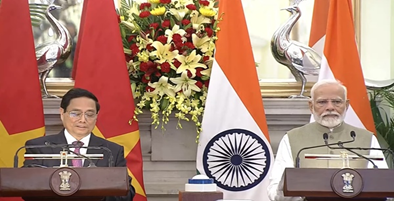
Key areas of Cooperation Between India and Vietnam:
- Historical Relations:
- Diplomatic Presence: India established a Consul General’s office in Hanoi in 1956; Vietnam established its diplomatic mission in India in 1972.
- Historical Support:
- India opposed US intervention in Vietnam, a stance that impacted Indo-US relations.
- India chaired the International Commission for Supervision and Control (ICSC), created under the Geneva Accord of 1954 to facilitate peace in Vietnam.
- Strategic Partnership: Elevated to ‘Strategic Partnership’ in July 2007 and to a “Comprehensive Strategic Partnership” in 2016.
- Economic Cooperation:
- Mekong-Ganga Cooperation (MGC): Aims to enhance ties between India and Southeast Asian nations, promoting development cooperation.
- Trade and Investment:
- Bilateral trade grew by 27% in FY 2021-22, reaching USD 14.14 billion.
- India is the 8th largest trading partner of Vietnam, and Vietnam is India's 15th largest trading partner and 4th in Southeast Asia.
- Capacity Building: India provides training programs and scholarships under the Indian Technical and Economic Cooperation (ITEC) to support Vietnam's socio-economic development.
- Political Backing:
- Support in International Forums: Vietnam supports India’s bids for permanent membership in the United Nations Security Council (UNSC) and accession to the Asia-Pacific Economic Cooperation (APEC).
- Multilateral Cooperation:
- Regional Forums: Both countries collaborate in ASEAN, East Asia Summit, Asia-Europe Meeting (ASEM), UN, and WTO.
- Defence Cooperation:
- High-Speed Patrol Boats: India extended a Line of Credit (LoC) of USD 100 million in September 2014 for 12 patrol boats for the Vietnamese border guard; an additional USD 500 million defence LoC was extended in 2016.
- Defense Vision Statement: Signed in June 2022, outlining a joint vision for defence partnership towards 2030.
- Joint Exercises: Conducts bilateral army exercises, such as Ex VINBAX.
- Maritime Security and Cooperation:
- Freedom of Navigation: Both countries support freedom of navigation and lawful commerce in international waters, in accordance with UNCLOS.
- South China Sea Code of Conduct: Emphasise that the Code of Conduct should align with UN conventions and respect the rights and interests of non-participating nations.
- Indian Diaspora in Vietnam:
- Population: Approximately 6,000 Indians, including short-term visitors.
- Primary Location: Predominantly in Ho Chi Minh City (HCMC), southern Vietnam.
- Occupations: Business and trading companies, Oil refineries, IT sector, Hotels and restaurants, Mining, Yoga institutions, Civil aviation, Schools
Key Outcomes of the Latest Bilateral Meeting:
- Agreements Signed:
- Total Agreements: Nine
- Key Areas of Cooperation: Customs, Agriculture, Legal matters, Broadcasting, Culture, Tourism
- Bilateral Trade:
- Current Value: $15 billion
- Objective: Enhance and increase bilateral trade further.
- Focus Areas for Enhanced Cooperation:
- Defence: Strengthen and implement existing defence agreements.
- Digital Technology: Leverage digital technologies to boost cooperation.
- Renewable Energy: Pursue closer collaboration in renewable energy sectors.
- Global Perspectives:
- Comprehensive Strategic Partnership: Emphasis on reinforcing the strategic partnership and aligning worldviews.
- Representation of Global South: Advocate for greater representation of the Global South in international forums.
- Implementation and Technological Advancements:
- Effective Implementation: Acknowledgment of successful implementation of defence cooperation agreements.
- Technological Role: Recognition of digital technologies in enhancing bilateral relations.
|
UPSC Civil Services Examination, Previous Year Question (PYQ) Prelims Q:1 In the Mekong-Ganga Cooperation, an initiative of six countries, which of the following is/are not a participant/ participant? (2015)
Select the correct answer using the code given below:
Ans: (c)
Q:1 Consider the following pairs: (2020) River Flows into
Which of the pairs given above is/are correctly matched?
Ans: (c) |
Source: IE
The Disaster Management (Amendment) Bill 2024
Why in the news?
- Recently, the Union Ministry of Home Affairs introduced the Disaster Management (Amendment) Bill 2024 in the Lok Sabha.

Key Aspects of the Disaster Management (Amendment) Bill 2024:
- Need for the Bill:
- Purpose of the 2005 Act: The Disaster Management Act (DMA) 2005 established mechanisms for disaster management, including:
- Developing and monitoring disaster management plans.
- Implementing measures for disaster prevention and mitigation.
- Coordinating disaster response and recovery efforts.
- Review and Recommendations:
- The Act has been reviewed based on past experiences and consultations with stakeholders, including state governments.
- The amendment seeks to integrate disaster management into development plans and aligns with the 15th Finance Commission's recommendations.
- Purpose of the 2005 Act: The Disaster Management Act (DMA) 2005 established mechanisms for disaster management, including:
Salient Provisions:
- Definition of Disaster Management: Includes disaster risk reduction through systematic efforts to:
- Reduce hazard exposure.
- Decrease vulnerability of people, property, and resources.
- Improve preparedness, resilience, and response capacity.
- Disaster Database: Establishment of national and state-level databases to include:
- Disaster assessments.
- Fund allocation and expenditure details.
- Preparedness and mitigation plans.
- Risk registers by type and severity.
- Urban Disaster Management Authority (UDMA): Formation of UDMA for state capitals and large cities (excluding Delhi and Chandigarh).
- State Disaster Response Force: Provision for the constitution of a State Disaster Response Force.
- Empowerment of NDMA: NDMA will periodically assess disaster risks, including emerging risks due to extreme climate events.
- Statutory Status: Provides statutory status to organisations like the National Crisis Management Committee and the High-Level Committee.
- Central and State Government Powers: Grants powers to direct actions for disaster impact reduction and impose penalties up to ₹10,000.
Significance of the Bill:
- Enhanced Clarity: Aims to clarify roles and responsibilities of disaster management authorities, addressing conflicts such as those seen in the Wayanad tragedy.
- Centralised Database: The creation of a comprehensive disaster database will improve resource allocation, coordination, and decision-making.
- Transformative Impact: Enhances the nation’s capacity for disaster risk reduction and environmental sustainability.
Criticisms:
- Authority Multiplicity: Concerns that the creation of multiple authorities may lead to confusion and bureaucratic inefficiencies, potentially hampering rescue and relief efforts.
- State Encroachment: Criticism that the Bill may encroach upon state functions by granting excessive rulemaking powers to the Central government, overlapping with state legislative powers.
Government Clarifications and Way Forward:
- Clarifications: The Bill is introduced under Entry 23 of the Concurrent List ("social security and social insurance, unemployment") and follows recommendations from a 2013 task force report.
- Way Forward: Examination of the Bill is needed to address potential conflicts with the federal structure and ensure that state powers are respected.
|
UPSC Civil Services Examination, PYQ Mains Q:1 Discuss the recent measures initiated in disaster management by the Government of India departing from the earlier reactive approach. (2020) |
Source: BS
Parkinson’s Disease
Why in the news?
- Recently, researchers have reported a higher-than-expected prevalence of gene mutations in Parkinson's disease patients, suggesting the need for broader genetic testing.

About Parkinson’s Disease:
- Nature: Parkinson’s Disease is a progressive neurological disorder affecting the nervous system and the body parts controlled by nerves.
- Control: It leads to limited or no control over movements and body balance.
- Age Factor: The risk of developing Parkinson’s disease increases with age, with an average onset at 60 years old.
- Gender Disparity: Studies indicate men are more likely to be affected by Parkinson’s than women.
Causes:
- Nerve Cell Degeneration: Caused by the degeneration of nerve cells in the substantia nigra, a brain region controlling movement.
- Dopamine Deficiency: These nerve cells lose their ability to produce dopamine, a chemical essential for movement coordination.
- Movement Impairment: Lack of dopamine results in slowed movements and tremors.
Symptoms:
- Variability: Symptoms vary among individuals and may start mildly.
- Asymmetry: Symptoms typically begin on one side of the body and remain more severe on that side.
- Primary Symptoms:
- Tremors: Trembling in hands, arms, legs, and jaw.
- Rigidity: Stiffness in the limbs.
- Bradykinesia: Slowness of movement.
- Postural Instability: Impaired balance and coordination.
- Additional Symptoms: Difficulty swallowing, chewing, and speaking; urinary problems; constipation; skin issues; depression; emotional changes; sleep disturbances.

Diagnosis:
- Current Limitations: No blood laboratory or radiological tests are currently available to diagnose Parkinson’s disease.
Treatment:
- Symptom Management: There is no cure for Parkinson’s disease, but treatments can significantly improve symptoms.
Current Major Advancements in Understanding Parkinson’s Disease:
- Genetic Exploration:
- Geneticists and neuroscientists are investigating genetic variations to gain a better understanding of Parkinson’s disease. Two primary approaches are being utilised:
- Linkage Analysis:
- Focuses on rare families with inherited parkinsonism, identifying gene mutations associated with the disease.
- Recent research identified a new genetic variant called RAB32 Ser71Arg linked to Parkinson’s in multiple families globally.
- Genome-wide Association Studies (GWAS):
- Compares genetic data from Parkinson’s patients and healthy individuals, identifying over 92 genomic locations and 350 genes potentially related to Parkinson’s risk.
|
UPSC Civil Services Examination Previous Year Question Prelims Q:1 Consider the following statements:
Which of the statements given above is/are correct?
Ans: (d) |
Source: TH
Hoollongapar Gibbon Wildlife Sanctuary
Why in the news?
- Recently, an approval by the Union Ministry of Environment, Forest and Climate Change (MoEFCC) for exploratory oil and gas drilling in parts of Hoollongapar Gibbon Wildlife Sanctuary may put the endangered Hoolock Gibbon at further risk.
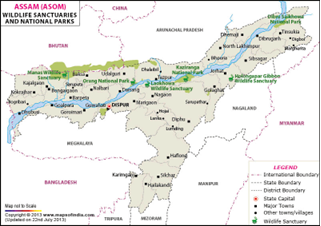
About Hoollongapar Gibbon Wildlife Sanctuary:
- Location: An isolated protected area of evergreen forest in the Jorhat district of Assam.
- Establishment: Granted wildlife sanctuary status in 1997 by the Assam Government.
- Unique Distinction: The only sanctuary in India named after a gibbon, containing the densest gibbon populations in Assam.
- Topography: Situated at an altitude between 100 and 120 meters (330 and 390 feet), the terrain gently slopes downward from southeast to northwest.
- River: The Bhogdoi River creates a waterlogged region dominated by semi-hydrophytic plants along the sanctuary's border.
Flora:
- Upper Canopy: Dominated by the Hollong tree.
- Middle Canopy: Dominated by the Nahar tree.
- Lower Canopy: Comprises evergreen shrubs and herbs.
Fauna:
- Primates: Home to India’s only gibbons–the Hoolock gibbons, and Northeastern India’s only nocturnal primate–the Bengal slow loris.
- Other Wildlife: Includes Indian elephants, tigers, leopards, jungle cats, wild boar, three types of civet, four types of squirrels, stump-tailed macaque, and northern pig-tailed macaque.
Key Facts About Hoolock Gibbons:
- About Hoolock Gibbons:
- Habitat: Hoolock Gibbons inhabit tropical and subtropical forests in Southeast Asia.
- Characteristics: Known as the smallest and fastest of all apes, they exhibit high intelligence, distinct personalities, and strong family bonds similar to other apes.
- Species: They are one of the 20 gibbon species found worldwide.
- India: Hoolock Gibbons are India's only ape species.
Gibbon Species in India:
- Western Hoolock Gibbon (Hoolock hoolock):
- Range: Inhabits all states of Northeast India, restricted to areas south of the Brahmaputra River and east of the Dibang River. Also found in eastern Bangladesh and north-west Myanmar.
- Conservation Status: Listed as Endangered on the International Union for Conservation of Nature's (IUCN) Red List.
- Eastern Hoolock Gibbon (Hoolock leuconedys):
- Range: Inhabits specific pockets of Arunachal Pradesh and Assam in India. Outside India, found in southern China and northeast Myanmar.
- Conservation Status: Listed as Vulnerable on the IUCN Red List.
Legal Protection in India:
- Both Western and Eastern Hoolock Gibbons are listed on Schedule 1 of the Indian Wildlife (Protection) Act, 1972.
|
UPSC Civil Services Examination, Previous Year Questions (PYQs) Prelims Q:1 Consider the following pairs: (2010)
Which of the pairs given above is/are correctly matched?
Ans: (b)
Q:2 Among the following, which one is not an ape? (2008)
Ans: C |
Source: HT
Tarang Shakti
Why in the news?
- Recently, India hosted the international air exercise ‘Tarang Shakti’ in two phases, taking place in Tamil Nadu and Rajasthan.

About the Tarang Shakti Military Exercise:
- Phases and Locations:
- Phase 1:
- Location: Sulur, Tamil Nadu
- Dates: August 6 to 14, 2024
- Phase 2:
- Location: Jodhpur, Rajasthan
- Dates: September 1 to 14, 2024
- Significance: This structure facilitates comprehensive participation across India's varied terrains.
- Phase 1:
- Participating Nations:
- Total Nations: Approximately 51
- Active Participants: About 30
- Confirmed Major Participants:
- United States
- Australia
- France
- Germany
- Japan
- United Kingdom
- Importance: Highlights the exercise's role in strengthening international defence relationships.
- Aircraft and Assets:
- Total Aircraft: Between 75 and 80 advanced military aircraft
- Indian Aircraft: 40
- International Aircraft: 32
- Notable Aircraft:
- Indian: LCA Tejas, Prachand light combat helicopter
- International: Rafale, Eurofighter Typhoon
- Indian Navy Contribution: MiG-29K planes
- Total Aircraft: Between 75 and 80 advanced military aircraft
Objectives:
- Enhancing Interoperability:
- Aim: Promote interoperability among the air forces of participating nations.
- Outcome: Enable sharing of best practices and improve operational coordination.
- Showcasing Indigenous Capabilities:
- Highlight: India's defence production capabilities.
- Platforms Featured: Tejas fighter, Prachand light combat helicopter, Akash missile system.
- Concurrent Event: A defence expo showcasing contributions from various Indian defence companies, including major public sector undertakings and innovative startups.
- Professional Exchange:
- Purpose: Facilitate professional exchanges among air forces.
- Platform: Learning and collaboration in modern aerial combat techniques.
Significance:
- Defence Diplomacy: Tarang Shakti-2024 is a major step forward for India's defence diplomacy.
- Self-Reliance: Demonstrates India's commitment to self-reliance in defence capabilities.
- International Standing: Strengthens India's position in international defence.
- Future Alliances: The beneficial contacts and cooperation fostered during the event will lay the foundation for future defence alliances among participating countries.
Source: IE
National Apprenticeship Training Scheme
- Union Education Minister Dharmendra Pradhan launched the National Apprenticeship Training Scheme (NATS) 2.0 Portal.
- Disbursed Rs 100 crore in stipends to apprentices through the Direct Benefit Transfer (DBT) mode.
- This initiative aligns with the government's focus on skilling and improving the employability of youth.
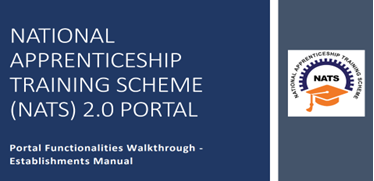
Key Highlights of the National Apprenticeship Training Scheme:
- Financial Support:
- Amount Disbursed: Rs 100 crore
- Mode of Transfer: Direct Benefit Transfer (DBT)
- Training Sectors:
- Sectors Involved: IT/ITes, manufacturing, automobile, etc.
- NATS 2.0 Portal:
- Purpose: To attract a large number of beneficiaries for registration and application for apprenticeships.
- Usage: Establishments and industries will use the portal to manage their vacancies and contracts.
- Objectives:
- Interoperability: Promote interoperability among the air forces of participating nations.
- Highlight Indigenous Capabilities: Feature platforms like the Tejas fighter, Prachand light combat helicopter, and Akash missile system.
- Professional Exchange: Facilitate learning and collaboration in modern aerial combat techniques.
- Panel Discussions:
- Topics Discussed:
- Apprenticeship Embedded Degree Programs
- Credits for all apprenticeships
- Industry and higher education collaboration
- Leveraging technology for DBT and e-Governance
- Attendees: Eminent dignitaries, academicians, and students.
- Topics Discussed:
- Recognition of Top Establishments:
- Top Three Recognized: Cognizant Technology Solutions Pvt Ltd., Infosys Ltd., and Tech Mahindra Pvt. Ltd.
- Minister's Address:
- Significance: NATS Portal 2.0 is a significant initiative to democratise apprenticeships, bridge the skills gap, and prepare youth for the future.
- Emphasis: Importance of competencies beyond degrees and the need for course curriculums to focus on employability skills.
- Budget Focus: This year's budget emphasises boosting skills and employment, calling for an expanded apprenticeship ecosystem.
- Encouragement to Stakeholders:
- Call to Action: Educational institutions and industries encouraged to join the NATS 2.0 portal.
- Objective: Make apprenticeships a widespread movement.
- Implementation of DBT:
- Purpose: Ensure timely, efficient, and transparent delivery of stipendiary benefits.
- Mechanism: Direct transfer of the government's stipend share to apprentices' bank accounts.
- Development and Functionality:
- Development: In-house by the Ministry of Education with support from AICTE and BoATs/BoPT.
- Functions: Manages the apprenticeship lifecycle, including student registration, vacancy advertisements, student applications, contract creation, certification, reporting, and stipend disbursal through DBT.
- Current Status: Initially used in pilot mode, now fully functional.
- Alignment with NEP 2020:
- NEP 2020 Goals: Mainstream vocational education and remove barriers between education streams.
- UGC and AICTE Guidelines: Draft guidelines for Apprenticeship Embedded Degree Programs (AEDP).
Source: NDTV
SC Allows for Sub-Classification of SCs and STs
Context:
- The Supreme Court of India has delivered a landmark verdict allowing states the authority to sub-classify Scheduled Castes (SCs) and Scheduled Tribes (STs) for the purpose of reservations.
- This 6-1 majority decision overturns the 2004 ruling in E.V. Chinnaiah vs. State of Andhra Pradesh, significantly altering reservation policies in India.
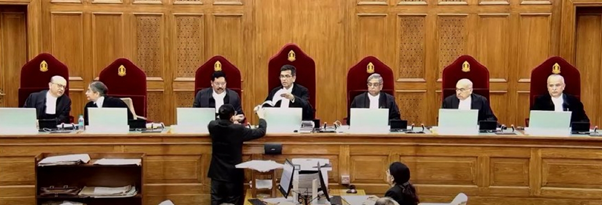
What is the Supreme Court’s Verdict on Sub-Classification of SCs and STs?
- Sub-Classifications Permitted:
- Decision: States are constitutionally allowed to sub-classify SCs and STs based on varying levels of backwardness.
- Implementation: States can sub-classify SCs within the 15% reservation quota to better support the most disadvantaged groups.
- Chief Justice’s Emphasis:
- Sub-Classification vs. Sub-Categorisation: The Chief Justice of India emphasised the difference between "sub-classification" and "sub-categorisation," warning against using these classifications for political purposes rather than genuine upliftment.
- Empirical Basis: Sub-classification must be based on empirical data and historical evidence of systemic discrimination, avoiding arbitrary or political motivations.
- Constraints and Guidelines:
- Reservation Limits: The Court clarified that 100% reservation for any sub- class is impermissible. Decisions on sub-classification are subject to judicial review to prevent misuse.
- Creamy Layer Principle: The 'creamy layer' principle, previously applied to Other Backward Classes (OBCs), is now extended to SCs and STs. States must exclude the creamy layer within SCs and STs from reservation benefits.
- Generational Limitation: Reservation benefits are limited to the first generation. If a family member has benefited from reservations and achieved higher status, subsequent generations will not be eligible.
- Rationale for the Verdict:
- Systemic Discrimination:
- The Court recognized that systemic discrimination hampers the advancement of some SCs and STs.
- Sub-classification under Article 14 of the Constitution helps address these disparities, allowing states to tailor reservation policies to support the most disadvantaged within these groups.
- Systemic Discrimination:
What is the Reference of the Sub-Classification Issue?
- Background:
- State of Punjab v. Davinder Singh (2020): A five-judge bench referred the sub-classification issue to a seven-judge bench to reconsider the E.V. Chinnaiah judgement.
- Reasons for Referral:
- Reconsideration of EV Chinnaiah Judgment: The five-judge bench deemed it necessary to revisit the 2004 ruling which had disallowed sub-classification within SCs.
- Punjab Scheduled Caste and Backward Classes (Reservation in Services) Act, 2006: The Act’s Section 4(5) mandated that 50% of SC-reserved vacancies be offered to Valmikis and Mazhabi Sikhs, contingent on their availability.
- High Court Ruling:
- Division Bench’s Decision: In 2010, the Punjab and Haryana High Court struck down Section 4(5), relying on the E.V. Chinnaiah judgement. The High Court ruled that all castes under Article 341(1) form a homogeneous group and cannot be further subdivided.
- Article 341 Context:
- Presidential Order: Article 341 empowers the President to identify and notify SCs in consultation with the Governor. The E.V. Chinnaiah judgement established this as the basis for reservations.
What are the Arguments for Sub-Classification?
- Enhanced Flexibility:
- Description: Sub-classification enables both central and state governments to create more tailored policies that address the specific needs of the most disadvantaged within SC/ST communities.
- Advantage: Allows for targeted support and resource allocation.
- Alignment with Social Justice:
- Description: By providing targeted benefits to those who need them most, sub-classification supports the constitutional goal of social justice.
- Advantage: Ensures that benefits are more equitably distributed.
- Constitutional Provisions:
- Article 16(4): Permits reservations for backward classes inadequately represented in state services.
- Article 15(4): Empowers states to make special arrangements for the welfare of socially and educationally backward classes.
- Article 342A: Supports states in maintaining their lists of socially and economically backward classes.
- Advantage: Provides constitutional backing for flexible reservation policies.
What are the Arguments Against Sub-Classification?
- Homogeneity of SCs and STs:
- Description: Critics argue that sub-classification undermines the uniform status of SCs and STs as recognized in the Presidential list.
- Concern: May disrupt the perceived equality and unity of these groups.
- Potential for Inequality:
- Description: Sub-classification could lead to further division and potentially exacerbate existing inequalities within the SC community.
- Concern: Might create new forms of disparity and competition among sub-groups.
What is the significance of the Supreme Court Verdict?
- Overruling Previous Judgement:
- Description: The Supreme Court’s decision reverses the E.V. Chinnaiah ruling, which previously held that SCs and STs were a homogeneous group and could not be subdivided for reservation purposes.
- Constitutional Impact: The ruling asserts that sub-classification does not violate Articles 14 or 341 of the Constitution.
- Impact on State Laws:
- Description: The verdict upholds state laws previously struck down, such as those in Punjab and Tamil Nadu, allowing for the creation of sub-categories within SC and ST groups.
- Example: Punjab’s 1975 notification for Valmikis and Mazhabi Sikhs, initially upheld, was challenged following the E.V. Chinnaiah judgement.
- Future of Reservations:
- Description: States now have the authority to implement sub-classification policies, potentially leading to more nuanced and effective reservation strategies.
- Precedent: Sets a new precedent for administering reservations, influencing similar cases and policies nationwide.
What are the challenges for Sub-Classification?
- Data Collection and Evidence:
- Description: Accurate and comprehensive data on the socio-economic conditions of different sub-groups within SCs and STs is crucial.
- Challenge: Ensuring data accuracy and avoiding biases in sub-classification decisions.
- Balancing Interests:
- Description: Sub-classification aims to uplift the most disadvantaged but requires balancing competing interests.
- Challenge: Managing variations across states while ensuring that sub-categories do not undermine overall reservation goals.
- Political Resistance:
- Description: Sub-classification policies may face opposition from political groups, causing delays and conflicts.
- Challenge: Navigating the political landscape to implement effective policies.
- Social Tensions:
- Description: Sub-classification might exacerbate existing social tensions within SC/ST communities, leading to intra-community conflicts.
- Challenge: Addressing potential divisions and promoting unity within communities.
- Administrative Burden:
- Description: Creating, managing, and updating sub-categories adds an administrative burden on government agencies.
- Challenge: Requires additional resources and manpower to handle the complexities of sub-classification.
Way Forward:
- Consider Historical Discrimination and Socio-Economic Factors:
- Description: States should take into account the historical discrimination, economic disparities, and social factors affecting different sub-groups within SCs and STs.
- Action: Ensure that sub-classification addresses genuine needs and is not influenced by political motivations.
- Leverage Upcoming Census Data:
- Description: Utilise the upcoming Census to collect comprehensive data on SCs and STs, including specific information on various sub-groups.
- Action: Gather detailed socio-economic data to inform sub-classification decisions.
- Establish Independent Data Verification:
- Description: Implement independent processes for verifying data to maintain credibility and transparency.
- Action: Ensure that data collection and analysis are free from bias and external influences.
- Define Clear and Objective Criteria:
- Description: Develop well-defined criteria for sub-classification, focusing on socio-economic indicators rather than caste or tribal affiliations alone.
- Action: Avoid subjective or politically motivated decisions by using objective measures.
- Monitor Impact and Adjust Policies:
- Description: Continuously monitor the impact of sub-classification policies and adjust them based on outcomes.
- Action: Ensure that benefits are effectively reaching the intended beneficiaries and make necessary adjustments to improve efficacy.
- Recognize Sub-Classification as a Temporary Measure:
- Description: View sub-classification as a temporary solution to address historical disadvantages while focusing on overall socio-economic development.
- Action: Prioritise broader socio-economic empowerment of SCs and STs, gradually reducing reliance on reservations as conditions improve.
|
UPSC Civil Services Examination, Previous Year Question: Prelims Q:1 Consider the following organisations/bodies in India: (2023)
How many of the above constitutional bodies?
Ans: (a)
Mains: Q:1 What are the two major legal initiatives by the State since Independence addressing discrimination against Scheduled Tribes (STs). (2017) |
Source: IE
Share the article
Edukemy’s Current Affairs Quiz is published with multiple choice questions for UPSC exams
MCQ
Get Latest Updates on Offers, Event dates, and free Mentorship sessions.

Get in touch with our Expert Academic Counsellors 👋
FAQs
UPSC Daily Current Affairs focuses on learning current events on a daily basis. An aspirant needs to study regular and updated information about current events, news, and relevant topics that are important for UPSC aspirants. It covers national and international affairs, government policies, socio-economic issues, science and technology advancements, and more.
UPSC Daily Current Affairs provides aspirants with a concise and comprehensive overview of the latest happenings and developments across various fields. It helps aspirants stay updated with current affairs and provides them with valuable insights and analysis, which are essential for answering questions in the UPSC examinations. It enhances their knowledge, analytical skills, and ability to connect current affairs with the UPSC syllabus.
UPSC Daily Current Affairs covers a wide range of topics, including politics, economics, science and technology, environment, social issues, governance, international relations, and more. It offers news summaries, in-depth analyses, editorials, opinion pieces, and relevant study materials. It also provides practice questions and quizzes to help aspirants test their understanding of current affairs.
Edukemy's UPSC Daily Current Affairs can be accessed through:
- UPSC Daily Current Affairs can be accessed through Current Affairs tab at the top of the Main Page of Edukemy.
- Edukemy Mobile app: The Daily Current Affairs can also be access through Edukemy Mobile App.
- Social media: Follow Edukemy’s official social media accounts or pages that provide UPSC Daily Current Affairs updates, including Facebook, Twitter, or Telegram channels.

